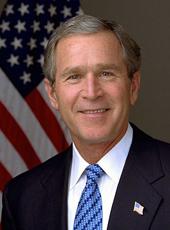Today, President Bush Announced U.S. Support For An Effort To Develop A New Post-2012 Framework On Climate Change By The End Of 2008. The plan recognizes that it is essential that a new framework include both major developed and developing economies that generate the majority of greenhouse gas emissions and consume the most energy, and that climate change must be addressed in a way that enhances energy security and promotes economic growth.
Under The President's Proposal, The United States Will Convene The Major Emitters And Energy Consumers To Advance And Complete The New Framework By The End Of 2008.
- The U.S. remains committed to the UN Framework Convention on Climate Change, and we expect the new framework to complement ongoing UN activity.
- The President's proposal breaks new ground in advancing areas of common interest between developed countries and the major emerging economies.
- The effort will build on and advance U.S. relations with the Asia-Pacific Partnership on Clean Development and Climate and other technology and bilateral partnerships.
The President's Proposal Is Based On The Principle That Climate Change Must Be Addressed By Fostering Both Energy Security And Economic Security, By Accelerating The Development And Deployment Of Transformational Clean Energy Technologies.
- The participants will develop parallel national commitments to promote key clean energy technologies.
- The proposal seeks to bring together the world's top greenhouse gas emitters and energy consumers.
- In creating a new framework, the major emitters will work together to develop a long-term global goal to reduce greenhouse gasses.
- Each country will work to achieve this emissions goal by establishing its own ambitious mid-term national targets and programs, based on national circumstances.
- They will ensure advancement towards the global goal with a review process that assesses each country's performances.
The President Proposes That All Countries Work Within The UN Process To Strengthen Programs Addressing
- Land management- Such as sustainable forestry and protecting the worlds forests;
- Energy efficiency;
- Advancing global transfer and adoption of clean energy technologies.
The United States Will Continue To Play A Leadership Role In Supporting Global Adoption Of Clean Technology By Promoting Low-Cost Capital Sources To Finance Investment In Development And Deployment Of Transformational Clean Energy Technologies.
- We will discuss ways to encourage more investment in developing nations – by making low-cost financing options for clean energy a priority for the international development banks. We will also work to conclude talks with other nations on eliminating tariffs and other barriers to clean energy technologies and services by the end of this year.
- America is leading the way with clean energy technology and is stepping up efforts to make advanced energy technology commercially viable.
- We are working to expand the use of clean coal technology, solar and wind energy, and clean, safe nuclear power.
- We are expanding the use of hybrid and clean diesel vehicles and biodiesel fuel.
- We are continuing to invest in new methods of producing ethanol – using everything from wood chips, to grasses, to agricultural wastes.
- We are pressing on with battery research for plug-in hybrid vehicles that can be powered by electricity from a wall-socket instead of gasoline.
- We are continuing research into advanced hydrogen-powered vehicles that emit pure water instead of exhaust fumes.
Today's Actions Build On The President's Continued Commitment To Our Energy Security And Our Environment
Since The President Took Office, The Federal Government Has Invested $12 Billion To Develop Cleaner, Cheaper, And More Reliable Energy Sources. We have now reached a pivotal moment where advances in technology are creating new ways to improve energy security, strengthen national security, and protect the environment. The President's "Twenty in Ten" goal will help achieve all these priorities.
The President Has Devoted $37 Billion To Climate Change-Related Activities Since 2001. The President has requested an additional $7.4 billion for FY 2008 – $205 million more than this year. This amount would support a wide range of climate change-related research, development, and deployment programs, voluntary partnerships, and international aid efforts.
The President Has Twice Increased Fuel Economy Standards For Light Trucks, Covering Model Years From 2005 Through 2011. The two actions cumulatively raised light truck fuel economy standards from 20.7 mpg prior to 2005, to 24 mpg in 2011. These actions are expected to save 14 billion gallons of fuel over the life of the affected vehicles, and reduce net greenhouse gas emissions by 107 million metric tons of carbon dioxide equivalent.
We Are Well On Track To Meet – And Currently Projected To Exceed – The President's 2002 Goal Of Reducing U.S. Greenhouse Gas Emission Intensity 18 Percent By 2012. U.S. greenhouse gas intensity declined by 2.5 percent in 2005, much faster than the average decline of 1.9 percent over the 1990-2005 period.
George W. Bush, Fact Sheet: A New International Climate Change Framework Online by Gerhard Peters and John T. Woolley, The American Presidency Project https://www.presidency.ucsb.edu/node/284598

